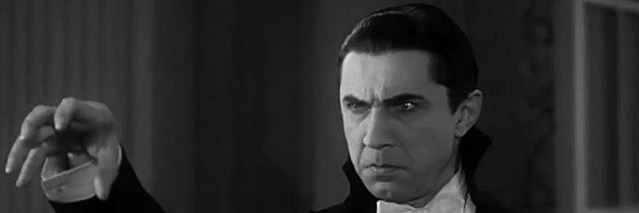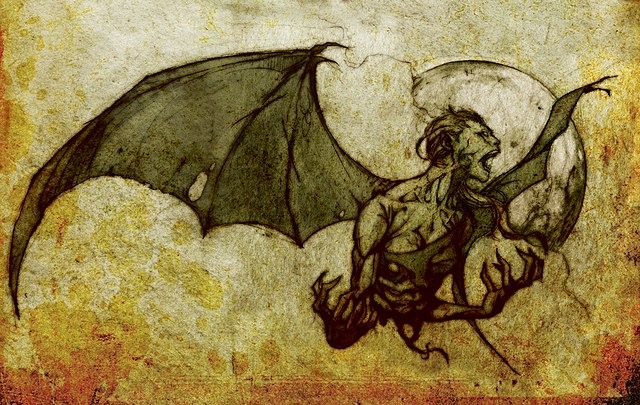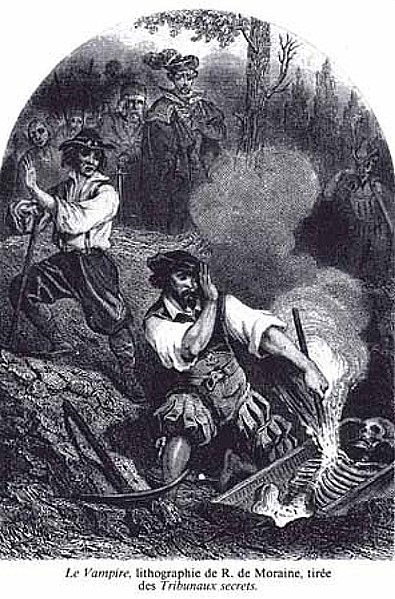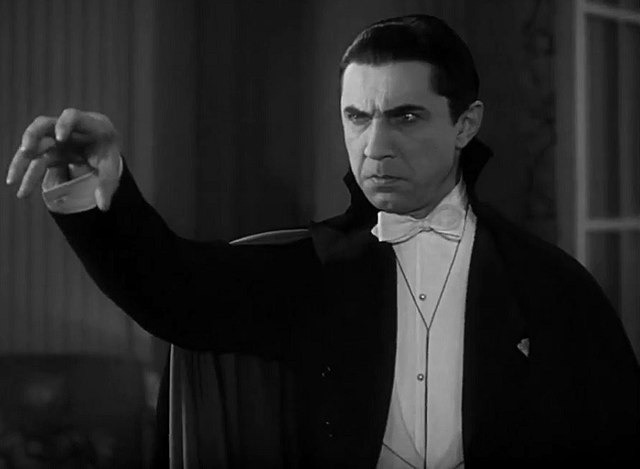Vampires are among the most common and popular creatures in the modern horror genre, but similar figures have been recorded in several cultures across the world for a long time. The typical trait that defines vampires is that they feed on the blood of living creatures, or another kind of vital essence. Other characteristics might be different, with the most common appearance of vampires, as undead humanoids with pale skin, coming from European folklore.
Ancient vampire-like creatures
The idea of blood-drinking creatures is extremely old, but in ancient times these were not vampires in the modern sense of the word, but rather demons or spirits. The oldest stories about blood-drinking demons come from the ancient Middle East, with the first appreance of these creatures recorded in Persian mythology, which featured demons drinking blood from men. Babylonian, Assyrian, and Jewish mythology instead included Lilith, a demon often depicted feeding on the blood of babies and their mothers. Other blood-sucking demons appear in ancient Mesopotamian folklore, like Lamashtu, which was described as kidnapping children to drink their blood and eat their flesh. Hebrew mythology also had more similar creatures, such as the alukah, a monster that mainly fed on the blood of animals.
Similar monsters also appear in ancient Greek and Roman mythology, such as Empusa, a female demon which attracted men to drink their blood, and Lamia, who preyed on both young men and children. Another creature which fed on human blood was the strix, a monster with a bird-like appearance that is also featured in Roman mythology. Ancient India instead had tales of vetalas, paranormal entities that possessed dead bodies and, like modern vampires, was associated with bats and hanged from trees upside-down.
Various regions of Africa also have tales of blood-drinking creatures. The Akan people of West Africa had the sasabonsam, a humanoid creature with bat-like wings who fed on people wandering into their territory in the forests. The adze of Ewe folklore instead took the form of a firefly, and sucked blood from people while they were sleeeping. Zulu mythology featured the impundulu, a large bird with an appetite for blood. The Betsileo people of Madagascar instead had tales of the ramanga, a living blood-drinking creature.
Numerous similar figures also appear in the folklore of various indigenous peoples of America, such as the soucouyant of Trinidad, and Tunda and Patasola of Colombia, which were all female blood-drinking demons. Instead, the Mapuche people of Chile had tales of the Piuchén, a shape-shifting creature that often appeared as a snake and drank blood. The blood-sucking rougarou that appears in the folklore of French settlers in America was instead more akin to a werewolf.
Legends of vampire-like creatures also appear in the folklore of Southeast Asia. These monsters appear with different names in numerous myths across the region, but they often have similar characteristics and are described as female. The mythology of the Philippines also featured another creature, the manananggal, a monster with fangs and wings who could separate part of his body and drank the blood of children and sleeping people. Chinese mythology instead featured the jiāngshī (or goeng si in Cantonese, literally meaning “stiffened corpse”), who are described as corpses that have returned to life and absorb the qi (life force) of living creatures at night, while resting during the day.
Depiction of a manananggal, a mythological vampire-like creature from the Philippines.
The origin of modern vampires
Many of the modern characteristics of vampires originated in medieval Europe and developed in the following centuries. The folklore of Southeastern Europe from this time is rich with this kind of creatures, such as the shtriga of Albanian mythology, a witch that sucked the blood of infants and turned into an insect. Greece had the vrykolakas, an undead being more similar to a zombie, while Romania had the moroi, strigoi, and pricolici, all of which were creatures that rose from the dead to drink the blood of the living. Similar monsters also appear in various forms in the legends of Slavic peoples, and were often described as dead people who rose from their graves and drank blood. Other similar stories can be found in the folklore of Ireland, Scotland, Iceland, and Spain. In some regions, especially in Bulgaria, it was a common practice to pin corpses through the heart with an iron stake to prevent them from returning as vampires.
Some of the earliest descriptions of modern vampires come from the Balkans and Eastern Europe in the 17th century, with recordings of people being frightened by these creatures. The first real person described as turning into a vampire after his death is Jure Grando, a Croatian villager from the town of Kringa, in Istria. He died from an illness in 1656 and, according to the legend, he returned from the grave at night to terrorize villagers, until the corpse was decapitated in 1672.
While the belief in many paranormal beings began to decline in the 18th century with the Age of Enlightenment, the reports of vampires increased significantly, especially in Southeastern Europe, which resulted in a case of mass hysteria throughout the continent. This phenomenon began with a series of alleged vampire attacks in East Prussia in 1721, and later expanded to other regions. The word vampire, which first appeared in the English language (as vampyre) in 1732 was used to describe these creatures, and might have a Slavic origin, but its etymology is still unclear.
Two famous incidents from Serbia became well-known throughout Europe. The first one was the tale of Petar Blagojević, a peasant who died and then allegedly returned from the dead as a vampire, killing various villagers. A similar story was told about Arnold Paole, a soldier who died and turned into a vampire, and killed other people who then also became vampires. These two cases even saw the involvement of Austrian authorities, who investigated the corpses of the two supposed vampires, and impacted the depiction of vampires in modern media. The mass hysteria caused by these incidents is known as the 18th-century vampire controversy, and several scholars investigated the matter. French monk and philosopher Antoine Augustin Calmet published a treaty on vampires and other paranormal creatures in 1751, suggesting that vampires existed, a claim disputed by Voltaire.
In Austria, Empress Maria Theresa sent her personal physician, Gerard van Swieten, to investigate the claims of vampiric entities, and he concluded that these creatures did not exist. This led to a series of new laws that prohibited the opening of graves and the desecration of corpses. Several other countries soon introduced similar laws, and the epidemic of vampirism ended. Nevertheless, the idea of vampires remained in popular culture, artistic works, and local superstition.
A lithography from 1864 showing people burning the alleged corpse of a vampire.
Vampires in modern popular culture
Vampires first appeared in literature in the 18th century, and were popularized as a characters in fiction by the 1819 short story The Vampyre by British writer John William Polidori. This is considered the first work of the modern vampire genre, and inspired several other writers. Important additions to the genre in the 19th century include the novel Varney the Vampire by James Malcolm Rymer and Thomas Peckett Prest, which described vampires as having sharp teeth, and Carmilla by Sheridan Le Fanu, which told the story of a lesbian vampire with romantic desires toward the protagonist.
The popularity of the genre culminated with the 1897 novel Dracula by Irish author Bram Stoker. This novel introduced the character of Count Dracula, considered as the archetype for all vampires, and popularized the tropes of the region of Transylvania being associated with vampires, vampirism being contagious, and these stories having sexual undertones. Some have suggested that the character was loosely inspired by the brutal acts of 15th-century Wallachian ruler Vlad the Impaler, also known as Vlad Dracula, but there is no consensus on this.
The 1921 silent Hungarian film Drakula halála became the first of many movies to feature Count Dracula. However, the German film Nosferatu from the following year was much more influential, and included the character of the same name, which was inspired by Count Dracula. The 1931 American film Dracula also helped popularize the character in movies, and deeply influenced not only the depiction of vampires, but the entire horror genre. Count Dracula has since appeared in countless works of fiction, most notably the British film Dracula in 1958, and the American film Bram Stoker’s Dracula in 1992.
Bela Lugosi as Count Dracula in the 1931 film Dracula.
However, there are also numerous other works featuring other vampires, including the TV series Dark Shadows, which aired between 1966 and 1971. Other works instead focused on vampire hunters, such as the Marvel character Blade, introduced in 1973, the 1992 comedy film Buffy the Vampire Slayer, which led to a TV series of the same name which aired between 1997 and 2003, and the 2004 film Van Helsing. In the 2000s, the novel series Twilight by American author Stephenie Meyer brought renewed attention on the vampire genre in a romantic setting, and also sparked a successful series of movies. Vampires now commonly appear in the horror genre in all forms of media, including books, movies, and video games.




